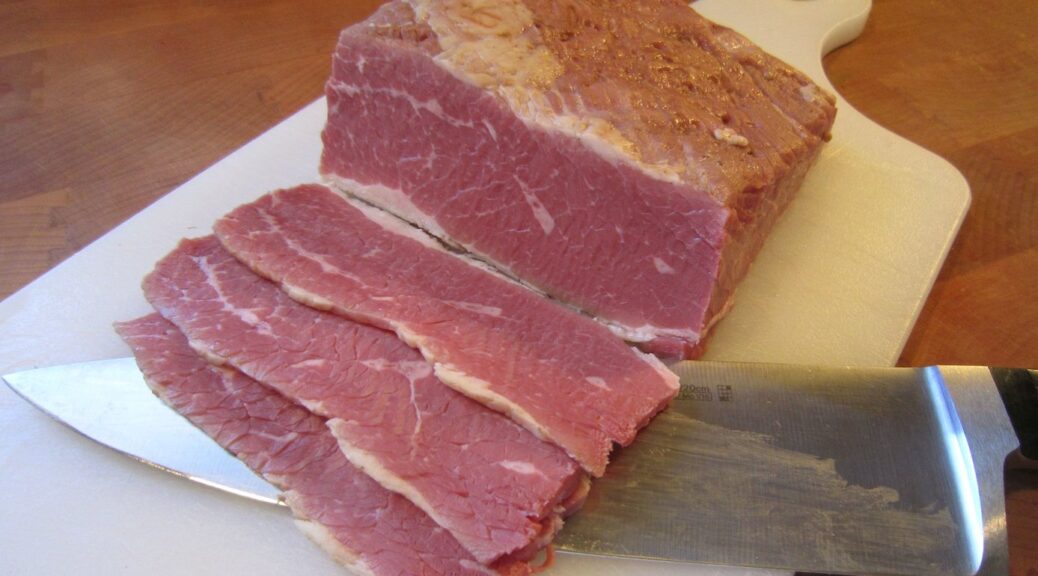
How to Make and Cook Corned Beef
Corned beef is cured with large-grained rock salt, also called “corns” of salt. This was a way to keep meat when it couldn’t be eaten fresh before it spoiled. Corned beef was eaten either hot or cold. If cold, it was pressed under a heavy weight before serving. Image: Libby, McNeill & Libby Corned Beef, 1898
INFORMATION BELOW FROM 1800s COOKBOOKS
TO CORN BEEF
Rub each piece of beef well with salt mixed with one-tenth part of saltpeter, until the salt lies dry upon the surface. Put aside in a cold place for twenty-four hours, and repeat the process, rubbing in the mixture very thoroughly. Put away again until the next day, by which time the pickle should be ready.
5 gallons of water.
1 gallon of salt.
4 ounces saltpeter.
1 and 1⁄2 lb. brown sugar.
Boil this brine ten minutes. Let it get perfectly cold, then pour over the beef, having wiped the latter entirely dry. Examine the pickle from time to time to see if it keeps well. If not, take out the meat without delay, wipe it, and rub in dry salt, covering it well until you can prepare new and stronger brine.
TO MAKE CORNED BEEF – Another Way
Do not attempt to corn any beef that has not been fresh killed. Have a quarter of beef cut into proper size and shape for nice roasting pieces.
Put it in a barrel of weak brine* and let it remain four days. Then make a brine that will bear an egg*, to which add:
1⁄2 pound saltpeter.
3 pounds brown sugar.
Transfer the beef to this barrel, cover closely, and let it remain a week. Put a weight on the meat to insure its being kept under the brine. Beef thus prepared in January will keep well through the month of March, improving with the lapse of time. It is best served cold. A valuable receipt* for country housekeepers.
*brine – salty water
*bear an egg – water salty enough for a fresh egg to float
*receipt – old-fashioned term for recipe
SPICED CORNED BEEF
6 pounds of brisket or the round of beef
1 pint of coarse salt
3 pints of water
3 dozen whole allspice
2 dozen whole cloves
This is a cheap and savory dish for luncheon and tea. Put the water and salt in a stewpan and set on the fire. Stir frequently until the water boils, and then skim carefully. Take from the fire and set away to cool. Remove the bones from the meat by slipping a sharp knife between the flesh and bone and cutting the meat from the bone. Place the beef in a stone jar or earthen bowl, and when the brine is cold, pour it over the meat. Cover the dish and set it away in a cool place for six or eight days, making sure to weight the meat so it stays under the brine.
At the end of that time remove the meat and wipe it. Spread it on a board and sprinkle the spice over it. Roll up and tie firmly. Place this roll in a kettle and cover it with boiling water. When the water begins to boil, (it will at first be somewhat cooled by the meat,) skim it carefully. Then set the kettle back where the water will just bubble for six hours. At the end of that time take the beef from the kettle and place it on a large dish. Put upon it a tin pan with weights, (two bricks will be sufficient,) and set away in a cool place. The meat should be cut in thin slices when served. Cold corned beef will keep very well for some days wrapped in several folds of a thick linen cloth, and set away in a cool dry place.
BOILED CORNED BEEF
If to be eaten hot, the round is the best piece. If cold and pressed, what are called “plate pieces,” the brisket, the flank, and the thin part of the ribs, may be used. Wash the meat and put into cold water, allowing half an hour to a pound after it begins to boil. If to be eaten cold, let it stand in the water till nearly cold, as this makes it richer. Take out all bones from a thin piece, wrap in a cloth, and put upon a large platter. Lay a tin sheet over it, and set on a heavy weight, flat-irons* will do, and let it stand over-night. Or the meat may be picked apart with a knife and fork; the fat and lean evenly mixed and packed into a pan, into which a smaller pan is set on top of the meat, and the weight in this. Thus marbled slices may be had. All corned beef is improved by pressing, and all trimmings from it can be used in hash or croquettes.
*flat-iron – a heavy metal iron heated by a fire or on a stove.
CORNED BEEF HASH
Cold cooked corned beef is best made into hash. Chop sufficient to make one pint. Chop the same quantity of cold boiled potatoes. Mix the two together, put them into a saucepan, add a half pint of stock, a tablespoon of butter, a teaspoon of onion juice and one-fourth teaspoon black or white pepper. Stir carefully and constantly until the mixture reaches the boiling point. Serve at once on buttered toast.
CORNED BEEF HASH No. 2
Chop enough cold cooked corned beef to make a pint. Chop the same quantity of cold boiled potatoes and mix the two together. Put them into a stewing pan, add one pint of stock and simmer for just a moment. Take from the fire, add two eggs well beaten and a dash of pepper. Turn the mixture into a baking dish and bake in a quick oven* twenty minutes.
*quick oven – about 400-450 degrees Fahrenheit.
CORNED BEEF AU GRATIN
1 and 1⁄2 cups milk
1⁄2 slice of onion
1 piece of celery
2 tablespoons flour
2 tablespoons butter
1 egg
1 teaspoon salt
1⁄4 teaspoon paprika
1 cup chopped corned beef
Place the milk, onion and celery over the fire. Allow to get very hot. Remove from the fire and let stand for ten minutes. Remove the celery and onion from the milk. Melt the butter, add the flour. Mix well and slowly add the milk. Cook until the consistency of white sauce. Add the egg, well beaten, the salt, paprika, and beef. Pour into well-buttered individual dishes.
Place in a moderate oven* and bake twenty-five minutes. Remove from the oven and allow to stand two minutes. Remove from the molds and garnish with parsley.
*moderate oven – about 350-400 degrees Fahrenheit.
CORNED BEEF HASH WITH BEETS
1 and 1⁄2 cups corned beef
2 cups cooked potatoes
1⁄2 cup cooked beets
1 teaspoon grated onion
2 tablespoons beef drippings
3⁄4 teaspoon salt
1 teaspoon Worcestershire sauce
1⁄4 cup stock or water
Have meat, potatoes, and beets coarsely chopped; add seasonings and stock; melt fat in frying pan, and, when very hot, add hash; cook slowly until a rich brown crust is formed; fold, and serve on a hot platter. If meat is very fat, use less fat in frying pan.
SCALLOPED CORNED BEEF
1 and 1⁄2 cups corned beef cut in half-inch cubes
2 tablespoons beef drippings
1 cup corned beef stock
5 tablespoons flour
1 teaspoon grated onion
1⁄4 teaspoon paprika
1⁄4 teaspoon celery sal
3⁄4 cup hot milk
1⁄2 cup buttered crumbs
Melt drippings, add flour, onion, and seasonings, and cook two minutes. Add the stock and milk, and stir until smooth. Add meat, and put into a greased baking dish. Cover with crumbs, and bake until crumbs are brown.
=================================================
Do You Like Corned Beef? Please Leave a Comment Below.
=================================================
Vintage Cooking Hints from the 1800s:
Saving Time and Labor in the Days Before Gas and Electricity
Step back in time….and imagine how difficult it was to prepare and cook food before gas and electricity was available. Any advice on saving time and labor was greatly appreciated.
These cooking hints were gathered from many cookbooks published in the 1800s.
=================================================

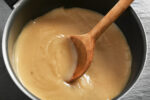
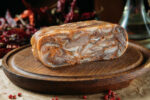
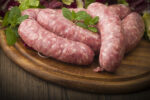
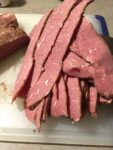
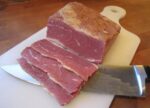
4 thoughts on “How to Make and Cook Corned Beef”
This is C-r-a-z-y! No wonder no one makes corned beef today. And all that saltpeter! The sad thing is, despite the outcries that imported corned beef contains traces of female hormone (I have no proof of that…), I still love it. However, it’s cheap enough I’ll buy it.
All that being said, I find your history of foods, full of explanation (corns of salt?) fascinating. And what a great idea. It seems you either inherited, borrowed, or bought old cookbooks. My grandmother had one with a date of something like 1906 (it was a fat book with brown specks on the edges of the pages). Breakfasts could run 6 courses. No wonder women were “pleasingly plump” in those days…
My mother had one cookbook and I think it was dated in the 1930s. All I ever made as a child were cookies and followed recipes for them. Later in life, I loved going to yard sales and thrift shops, looking for books. I’m an avid mystery reader, but gravitated toward cookbooks, too. I found one at an estate sale dated 1884. The cover was off, but I love it. And nowdays, many older cookbooks are digitized. I use Project Gutenberg. I sure admire all the volunteers who help save old books and transcribe them for the public. https://www.gutenberg.org/wiki/Main_Page
I really appreciate your dedication to Victorian cooking! I am hoping to get more into it this year – with the aim of having a complete Victorian Christmas dinner this year. Of course corned beef is perfect for St. Patrick’s Day.
Again, I appreciate your focus on historic details. It just makes the hobby so much more interesting.
Thank you. I enjoy looking through the old cookbooks. A Victorian Christmas dinner would be so fun.